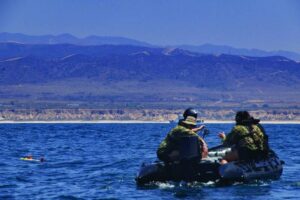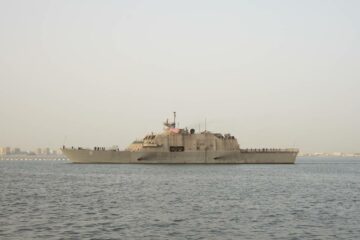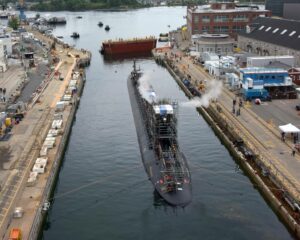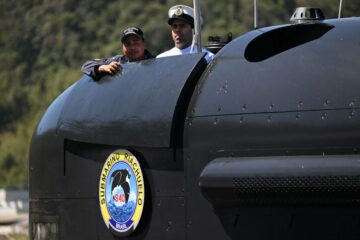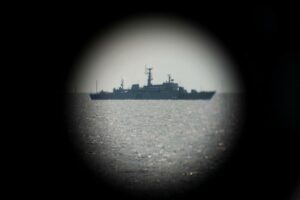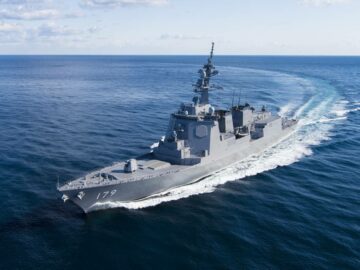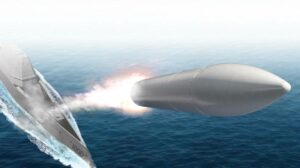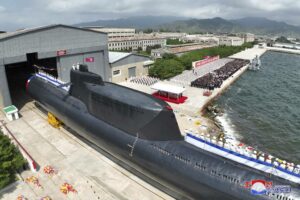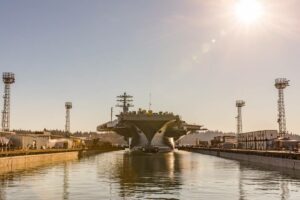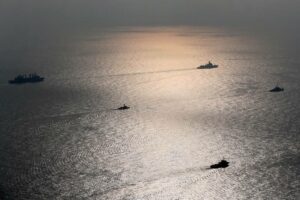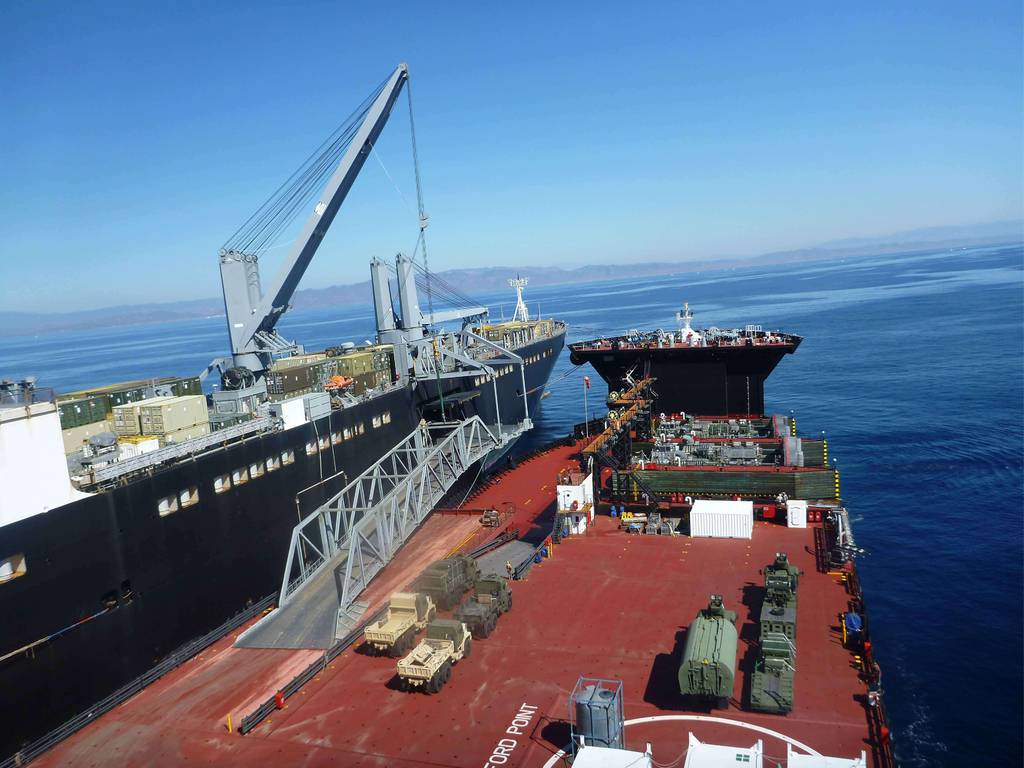
WASHINGTON — The U.S. Marine Corps is taking the first step to define its next-generation maritime pre-positioning ship, which will be smaller than the vessels currently serving that purpose, but still able to support distributed maritime operations.
The Corps is already rethinking how it will sustain small units dispersed around an operating area, including island chains in the Pacific Ocean.
An update this month to the service’s Force Design 2030 modernization plan announced the creation of a global positioning network to support the Distributed Maritime Operations concept, which outlines how to sustain Marines in day-to-day campaigning and during a crisis or conflict.
During a June 28 panel discussion at the annual Modern Day Marine exposition, Rick Betsinger, the expeditionary ship capabilities branch chief, said the global positioning network is a combination of ashore and afloat pre-positioned stocks. But a new ship is needed to support the afloat part.
“We’re going to go to more distributed platforms; we’re going to get right-sized ships that are not tied to strategic water ports but that can operate in and out of secondary and tertiary ports,” he said during his presentation.
He told Defense News that the Large, Medium-Speed Roll-on/Roll-off ships currently in the fleet will have a role in the near term, but added that Marines will eventually need ships that can access smaller ports to give operational commanders more options to resupply their forces.
The Navy is also pursuing a smaller logistics ship for its distributed maritime operations. This Light Replenishment Oiler, formerly called the Next-Generation Logistics Ship, is undergoing research and development. It’s expected to enter a procurement phase in fiscal 2026.
Shon Brodie, the director of the Maritime Expeditionary Warfare Division at the Marine Corps’ Capability Development Directorate, said that “maritime pre-positioning, as I knew it as a kid, was built on the endurance and capacity of a ship, with the speed of airlift. So we combined those two, [and it] worked brilliantly.”
“That’s how anti-access/area denial was born,” the retired Marine sergeant major added.
Due to anti-access/area denial advances by China and other U.S. rivals, a large supply ship would certainly be targeted in a conflict as a means of disrupting Marine Corps operations. Smaller ships that can blend in or split enemy targeting capabilities will have a better chance of successfully getting their supplies to distributed Marine units.
Brodie also said today’s Large, Medium-Speed Roll-on/Roll-off ships are good at delivering bulk quantities of items but are less useful in day-to-day operations, something he wants to change with this next-generation maritime pre-positioning ship, dubbed MPS(X).
“Now, if I have to issue something from the old maritime pre-position ship, I have to issue it at the wholesale level. If you ask for a tire, I’ve got to unload a lot of stuff to get you a tire,” he said. “I want to be able to issue it at the retail level, and I want to use that ship all the time, not just in case we have a war. I want to use it in campaigning, and I want to sustain the force all the time.”
Marines in Hawaii are conducting a tabletop exercise this week to work through how the MPS(X) would operate and support forward forces. Betsinger said the service is just now getting into the requirements development process, and that an analysis of alternatives will take place within the next 12 months.
That analysis will inform the capability development document, which should be completed by mid-2024.
Betsinger said he hopes to have a new ship to begin using around 2030.
Megan Eckstein is the naval warfare reporter at Defense News. She has covered military news since 2009, with a focus on U.S. Navy and Marine Corps operations, acquisition programs and budgets. She has reported from four geographic fleets and is happiest when she’s filing stories from a ship. Megan is a University of Maryland alumna.
- SEO Powered Content & PR Distribution. Get Amplified Today.
- PlatoData.Network Vertical Generative Ai. Empower Yourself. Access Here.
- PlatoAiStream. Web3 Intelligence. Knowledge Amplified. Access Here.
- PlatoESG. Automotive / EVs, Carbon, CleanTech, Energy, Environment, Solar, Waste Management. Access Here.
- BlockOffsets. Modernizing Environmental Offset Ownership. Access Here.
- Source: https://www.defensenews.com/naval/2023/06/28/us-marine-corps-begins-developing-smaller-pre-positioning-ship/
- :has
- :is
- :not
- 11
- 12
- 12 months
- 2026
- 2030
- 28
- 70
- a
- Able
- access
- acquisition
- added
- advances
- All
- already
- also
- alternatives
- an
- analysis
- and
- announced
- annual
- ARE
- AREA
- around
- AS
- At
- BE
- begin
- Better
- Blend
- born
- Branch
- Budgets
- built
- but
- by
- called
- campaigning
- CAN
- capabilities
- capability
- Capacity
- case
- certainly
- chains
- Chance
- change
- chief
- China
- combination
- combined
- Completed
- concept
- conducting
- conflict
- covered
- creation
- crisis
- Currently
- day
- day-to-day
- Defense
- delivering
- Design
- developing
- Development
- Director
- discussion
- dispersed
- distributed
- Division
- document
- dubbed
- during
- Enter
- eventually
- Exercise
- expected
- Filing
- First
- Fiscal
- FLEET
- Focus
- For
- Force
- Forces
- formerly
- Forward
- four
- from
- geographic
- get
- getting
- Give
- Global
- Go
- going
- good
- Have
- hawaii
- he
- his
- hopes
- How
- How To
- HTTPS
- i
- if
- images
- in
- Including
- inform
- into
- island
- issue
- IT
- items
- ITS
- jpg
- june
- just
- Kid
- large
- less
- Level
- light
- logistics
- Lot
- major
- Marine
- Maritime
- Maryland
- means
- Megan
- Military
- Modern
- modernization
- Month
- months
- more
- Near
- Need
- needed
- network
- New
- news
- next
- next-generation
- now
- ocean
- of
- Old
- on
- operate
- operating
- operational
- Operations
- Options
- or
- Other
- out
- outlines
- Pacific
- Pacific Ocean
- panel
- panel discussion
- part
- Place
- plan
- Platforms
- plato
- Plato Data Intelligence
- PlatoData
- ports
- positioning
- presentation
- process
- procurement
- Programs
- purpose
- Reported
- reporter
- Requirements
- research
- research and development
- retail
- rivals
- Role
- s
- Said
- secondary
- service
- serving
- she
- ships
- should
- since
- small
- smaller
- So
- something
- speed
- split
- Step
- Still
- Stocks
- Stories
- Strategic
- Successfully
- supply
- support
- Take
- taking
- targeted
- targeting
- term
- tertiary
- than
- that
- The
- their
- this
- this week
- those
- Through
- Tied
- time
- tire
- to
- today’s
- two
- u.s.
- U.S. Navy
- undergoing
- units
- university
- University of Maryland
- Update
- us
- use
- using
- want
- wants
- war
- was
- Water
- we
- week
- when
- which
- wholesale
- will
- with
- within
- Work
- worked
- would
- X
- you
- zephyrnet

